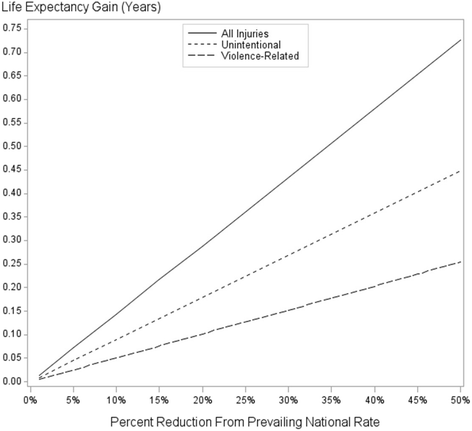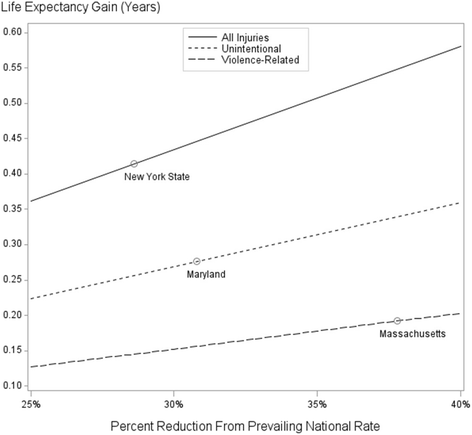Increases in United States life expectancy through reductions in injury-related death
- PMID: 28854976
- PMCID: PMC5577772
- DOI: 10.1186/s12963-017-0150-4
Increases in United States life expectancy through reductions in injury-related death
Abstract
Background: During the previous century the average lifespan in the United States (US) increased by over 30 years, with much of this increase attributed to public health initiatives. This report examines further gains that might be achieved through reduced occurrence of injury-related death.
Methods: US life tables and injury death rate data were used to estimate potential increases in life expectancy assuming various reductions in the rate of fatal injuries. Corresponding numbers of deaths potentially averted annually were also estimated; unit (per death) medical and lifetime work loss costs were employed to estimate total costs potentially averted annually.
Results: Through elimination of injury as a cause of death, average US life expectancy at birth could be increased by approximately 1.5 years, with notable variations by sex, ethnicity, and race. More conservatively, average life expectancy at birth could be increased by 0.41 years assuming that the national injury death rate could be brought into line with the lowest state-specific rate. Under this more conservative but plausible assumption, an estimated 48,400 injury deaths and $61 billion in medical and work loss costs would be averted annually.
Conclusions: Increases in life expectancy of the magnitude considered in this report are arguably attainable based on long-term historical reductions in the US injury death rate, as well as significant continuing reductions seen in other developed countries. Contemporary evidence-based interventions can play an important role in reducing injury-related deaths, such as those due to drug overdoses and older adult falls, as well as suicides.
Keywords: Cost of injury; Injury death; Life expectancy.
Conflict of interest statement
The authors declare that they have no competing interests.
Figures
References
-
- Web-based Injury Statistics Query and Reporting System (WISQARS). Centers for Disease Control and Prevention, National Center for Injury Prevention and Control, Atlanta. 2016. https://www.cdc.gov/injury/wisqars. Accessed 20 Apr 2017.
-
- Doll LS, Saul JR, Elder RW. Injury and violence prevention interventions: an overview. In: Doll LS, Bonzo SE, Sleet DA, Mercy JA, Hass EN, editors. Handbook of injury and violence prevention. New York: Springer; 2007. pp. 21–32.
Publication types
MeSH terms
LinkOut - more resources
Full Text Sources
Other Literature Sources
Medical



